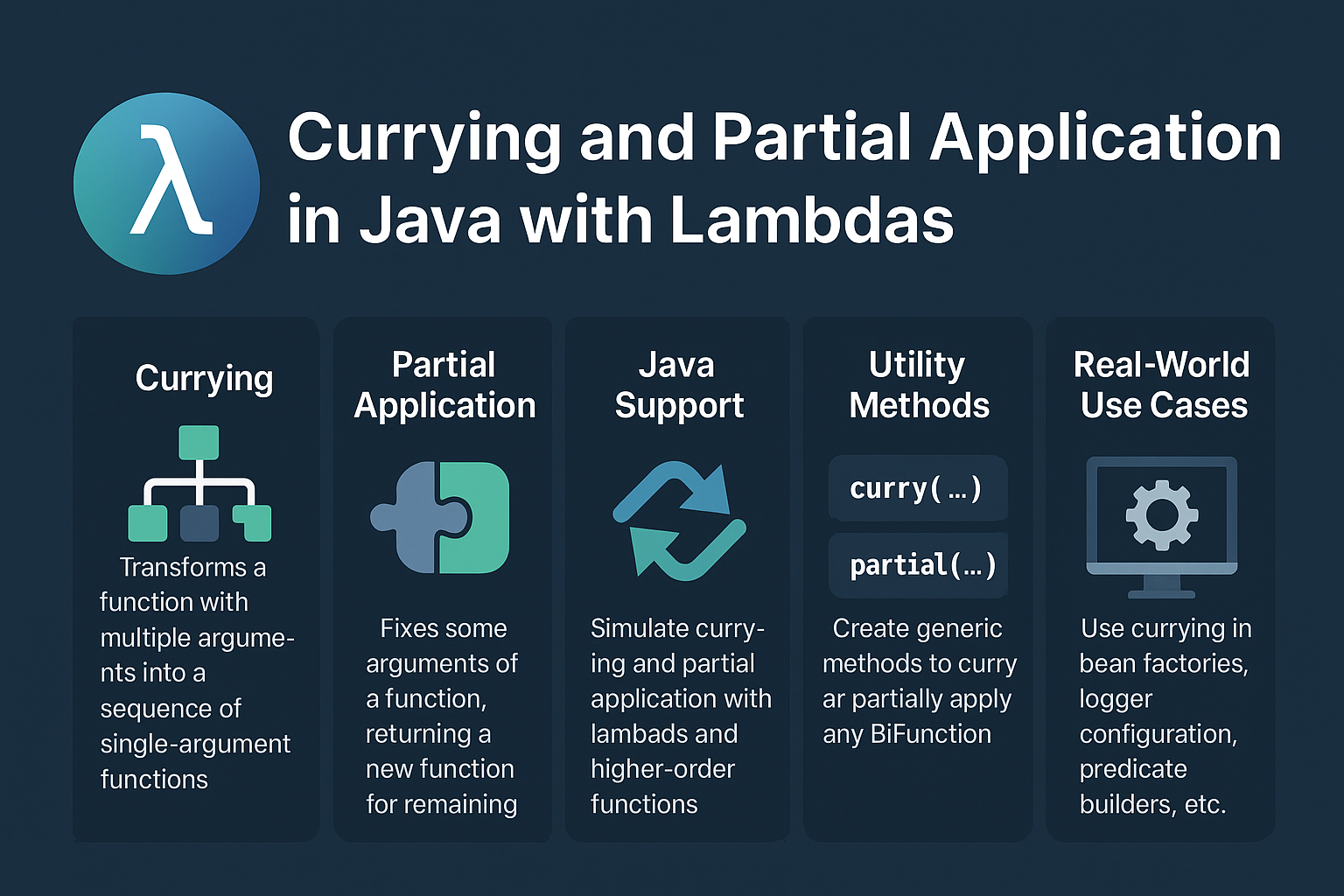In functional programming, currying and partial application are powerful techniques to simplify complex functions, increase code reuse, and improve modularity. While Java isn’t a purely functional language, it supports these concepts through lambdas and higher-order functions.
In this tutorial, we’ll explore what currying and partial application mean, how to implement them in Java, and where they shine in real-world code.
🔍 What Is Currying?
Currying transforms a function that takes multiple arguments into a sequence of functions that each take one argument.
Example:
Function<Integer, Function<Integer, Integer>> add = a -> b -> a + b;
Function<Integer, Integer> add5 = add.apply(5);
System.out.println(add5.apply(3)); // 8
Instead of taking two arguments directly, the add function returns another function.
🧠 What Is Partial Application?
Partial application fixes a few arguments of a function and returns a new function that takes the remaining ones.
Example:
BiFunction<Integer, Integer, Integer> add = (a, b) -> a + b;
Function<Integer, Integer> add5 = b -> add.apply(5, b);
System.out.println(add5.apply(10)); // 15
Partial application is similar to currying, but it works by fixing known values to a multi-parameter function.
🔧 Java Support for Currying and Partial Application
Java does not have native support for currying or partial application syntax, but you can simulate both using functional interfaces, lambdas, and higher-order functions.
Custom Functional Interface for Currying
@FunctionalInterface
interface CurriedFunction<T, U, R> {
Function<U, R> apply(T t);
}
Partial Application with BiFunction
BiFunction<String, String, String> greet = (title, name) -> title + " " + name;
Function<String, String> greetMr = name -> greet.apply("Mr.", name);
System.out.println(greetMr.apply("Smith")); // Mr. Smith
🛠️ Currying Utility Methods
Currying a BiFunction
public static <T, U, R> Function<T, Function<U, R>> curry(BiFunction<T, U, R> f) {
return t -> u -> f.apply(t, u);
}
Partial Application Utility
public static <T, U, R> Function<U, R> partial(BiFunction<T, U, R> f, T fixed) {
return u -> f.apply(fixed, u);
}
Usage
BiFunction<Integer, Integer, Integer> multiply = (a, b) -> a * b;
Function<Integer, Function<Integer, Integer>> curried = curry(multiply);
Function<Integer, Integer> times10 = curried.apply(10);
System.out.println(times10.apply(5)); // 50
🔁 Function Composition + Currying
You can compose curried functions for pipelines:
Function<Integer, Function<Integer, Integer>> multiply = a -> b -> a * b;
Function<Integer, Integer> times2 = multiply.apply(2);
Function<Integer, Integer> plusOne = x -> x + 1;
Function<Integer, Integer> pipeline = times2.andThen(plusOne);
System.out.println(pipeline.apply(4)); // 9
🔂 Real-World Use Cases
1. Spring Bean Factories
Function<String, Function<Integer, User>> userFactory = name -> age -> new User(name, age);
2. Logger Configuration
Function<Level, Consumer<String>> createLogger = level -> msg -> System.out.println(level + ": " + msg);
Consumer<String> infoLogger = createLogger.apply(Level.INFO);
3. Reusable Predicate Builders
Function<String, Predicate<String>> containsBuilder = keyword -> s -> s.contains(keyword);
Predicate<String> containsError = containsBuilder.apply("ERROR");
📏 Scoping and Captures
Currying often creates closures:
Function<Integer, Function<Integer, Integer>> add = a -> {
int offset = 1;
return b -> a + b + offset;
};
Here, offset is captured from the outer scope — typical in closures.
🚫 Anti-Patterns and Pitfalls
- Excessive currying can reduce readability.
- Avoid currying in performance-critical sections (due to object allocation).
- Don’t overuse currying with more than 3–4 parameters.
🔐 Thread Safety Considerations
Closures in currying may capture mutable variables. Avoid this.
int[] counter = new int[]{0};
Function<Integer, Function<Integer, Integer>> f = a -> b -> a + b + counter[0]; // Not thread-safe
Use AtomicInteger or avoid shared mutable state.
📘 Integration Examples
Spring + Currying
@Bean
public Function<String, Function<Integer, User>> userCreator() {
return name -> age -> new User(name, age);
}
JavaFX + Partial Application
BiConsumer<Button, String> setup = (button, text) -> button.setText(text);
Consumer<String> labelSetter = text -> setup.accept(myButton, text);
📌 What’s New in Java Versions?
Java 8
- Lambda expressions
- Functional interfaces
Function<T, R>for building curried chains
Java 9
- Stream and Optional improvements
Java 11+
varin lambdas
Java 21
- Scoped values for managing captured state
- Structured concurrency with lambda compatibility
- Virtual threads supporting lambda workflows
❓ FAQ
1. Is currying supported natively in Java?
No, but you can simulate it using functions returning functions.
2. What is the benefit of currying?
It improves reusability and separation of concerns.
3. When should I use partial application?
When some arguments are known and reused often.
4. What’s the difference between currying and partial application?
Currying transforms arity; partial application fixes known parameters.
5. Can I curry more than two arguments?
Yes — just nest more function returns.
6. Are curried functions reusable?
Yes — store them in variables or inject via DI frameworks.
7. Is there a performance impact?
Minimal, but avoid overcurrying in tight loops.
8. Can I compose curried functions?
Yes — use andThen(), compose() on returned functions.
9. Are lambdas used in currying thread-safe?
Only if they don’t capture mutable shared state.
10. How do I test curried functions?
Invoke with fixed values and assert the result of the returned function.
✅ Conclusion and Key Takeaways
Currying and partial application let you break down logic into smaller, reusable functions. Java’s support for lambdas makes it possible to apply these concepts effectively, even in an object-oriented world. Use them wisely for clean, composable, and testable code.
